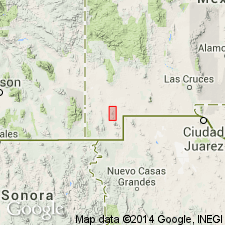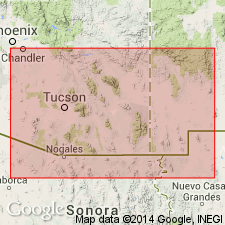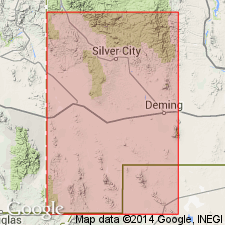
- Usage in publication:
-
- Playas Peak formation*
- Modifications:
-
- Original reference
- Dominant lithology:
-
- Sandstone
- Shale
- AAPG geologic province:
-
- Pedregosa basin
Summary:
Pg. 534, figs. 2, 4; USGS Prof. Paper 208, p. 24-25, pl. 1, 1947. Playas Peak formation of Bisbee group. Sandstone and shale underlain in Eureka section by a basal conglomerate and capped by massive ORBITOLINA-bearing limestones. Basal conglomerate locally bouldery and unsorted. Thickness in Eureka section, where both contacts are disconformable, ranges from 800 to 2,000 feet; in Sylvanite section exposed section between 3,000 and 3,500 feet. In Eureka district, underlies Skunk Range conglomerate (new) and overlies Corbett sandstone (new), both of Bisbee group. Age is Early Cretaceous (Trinity); freshwater shells and fragments of wood collected. Report includes geologic map.
Named from Playas Peak, in sec. 5, T. 28 S., R. 16 W., in Eureka half of Little Hatchet Mountains, southwestern NM (Pedregosa basin and Basin-and-Range province). [According to GNU records (USGS DDS-6; Denver GNULEX, Mar. 18, 1986), type locality not designated.]
Source: US geologic names lexicon (USGS Bull. 1200, p. 3062); supplemental information from GNU records (USGS DDS-6; Denver GNULEX).

- Usage in publication:
-
- Playas Peak Formation*
- Modifications:
-
- Revised
- AAPG geologic province:
-
- Pedregosa basin
- Basin-and-Range province
Summary:
Is formation in Little Hatchet Mountains, Hidalgo and Grant Cos, AZ in the Pedregosa basin and Basin-and-Range province. Together with Howells Ridge Formation and Broken Jug Limestone of same area, all are interpreted to be faulted repetitions of the same unit. Is not considered part of Bisbee Group; changed from previous work by Lasky (1947). Bisbee Group not used locally in this paper. "Disconformable contact" at base (Lasky, 1947) is believed to be a fault. Underlies Skunk Ranch Conglomerate (Upper Cretaceous) in southern part of Little Hatchet Mountains with erosional unconformity. Thickness (following Lasky, 1947) more than 3,000 ft. Upper few hundred ft characterized by thick-bedded to massive rudistid-bearing bioherms and ORBITOLINA-bearing beds of Trinity (Aptian and Albian, Early Cretaceous) age. Is correlated with U-Bar Formation (Aptian and Albian) of Zeller, Jr. (1965) in Big Hatchet Mountains o basis of lithology and fossils. Is Neocomian, Aptian, and Albian (Early Cretaceous) age. [See fig. 5 for regional correlation.]
Source: GNU records (USGS DDS-6; Denver GNULEX).

- Usage in publication:
-
- Playas Peak Formation
- Modifications:
-
- Not used
Summary:
As mapped by Lasky (1938) replaced by Ringbone Formation of Late Cretaceous age in Little Hatchet Mountains. [Some rocks mapped by Lasky as Playas Peak were included in U-Bar Formation of Early Cretaceous age by Zeller. Because of the generally accepted faulted duplication of the sequence in the Little Hatchet Mountains as defined by Lasky (1938), probably most of his Cretaceous units, including Playas Peak Formation, should be replaced by the better-defined and more widely used terminology of Zeller (1970).] Is of Late Cretaceous age.
Source: GNU records (USGS DDS-6; Denver GNULEX).
For more information, please contact Nancy Stamm, Geologic Names Committee Secretary.
Asterisk (*) indicates published by U.S. Geological Survey authors.
"No current usage" (†) implies that a name has been abandoned or has fallen into disuse. Former usage and, if known, replacement name given in parentheses ( ).
Slash (/) indicates name conflicts with nomenclatural guidelines (CSN, 1933; ACSN, 1961, 1970; NACSN, 1983, 2005, 2021). May be explained within brackets ([ ]).

